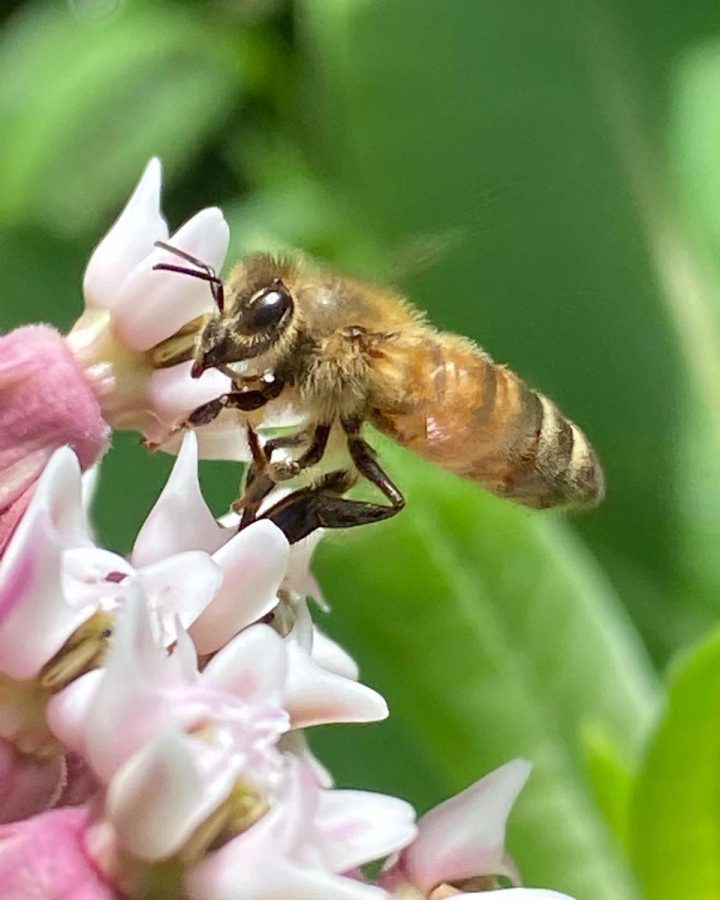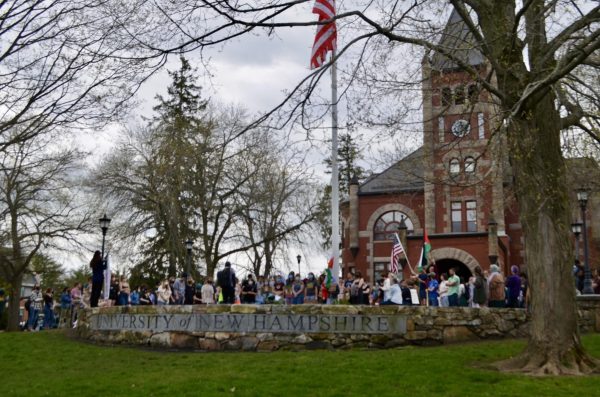Warming Winters Pose Threat to Honey Bees in New England
May 14, 2023
RYE, NH– The sky is a deep shade of blue as the sun shines down on Joe Marttila’s beehives. Artwork by children from local schools decorates the outside of his hives. Honey bees filter in and out, passing through these hand-painted floral landscapes. Marttila watches his bees enjoy the warm weather which celebrates the end of March and the start of April. Growing up on the Seacoast, Marttila had a neighbor who kept bees.
“I was fascinated by it,” Marttila said. “So as a kid, I’d go out and watch the bees.” Many years later, Marttila still watches bees, but these are his own and with fascination in his tone, he talks about them.
“They’re all different,” said Marttila. “Some, on a day like today, they’re not gonna fly, but others will.”
It was 45 degrees Fahrenheit and clouds were few and far between. One hive laid silent, clustered together for warmth, their presence only verified when looking under the hive’s roof. Another hive’s buzzing could be heard from outside as the bees took off, searching for forage, enjoying the almost warm weather.
New England winters are becoming warmer due to climate change. This can help honey bees survive the season, but it also helps harsh pests that threaten the bees in other ways. In addition, the warm weather can confuse the bees into leaving the hive for forage, which does not yet exist. If they cannot get back to the hive before the temperature drops down, they will die.
New Hampshire winters are warming much faster than any other season, according to an analysis of meteorological data summarized in the 2021 New Hampshire Climate Assessment. Winter minimum temperatures across New Hampshire have increased by 5.9 degrees Fahrenheit over the past five decades. Winter temperatures are projected to increase another four to seven degrees Fahrenheit by the middle of the 21st century, with higher rates of warming projected for the scenario based on high emissions of greenhouse gasses.
The pests that honey bees deal with, such as Varroa mites, Wax moths and Yellowjackets, do not die until the first frost of the year. Marttila said that the first frost used to be in September, but now there are years where the first killing frost doesn’t happen until November. It is unclear what will happen as winter temperatures continue to increase.
Janice Mercieri, owner of White Mountain Apiary in Whitefield, NH, and 2021 NH Beekeeper of the Year, said that the shift in our weather patterns due to climate change has also made a difference in the way that bees are kept.
Many beekeepers in the North Country have begun keeping their bees indoors in sheds and barns to equalize the weather, said Mercieri. This helps keep them cooler and darker throughout the winter, preventing them from coming out when they shouldn’t.
Mercieri described a day in February 2022 when it was 70 degrees Fahrenheit. The warm weather fooled her bees into leaving the hive for forage, of which there was none. The temperature dropped down before the bees could make it back to their hive. Mercieri lamented, “We lost those.”
Marttila also lost a hive that way. He explained that the bees form a cluster within the hive to survive cold temperatures in winter as a colony. On warm days, when the bees leave to forage, they break that cluster. If they cannot make it back to the hive to cluster before the temperature drops back down, the whole hive will be lost.
Marttila doesn’t see this as a significantly impactful issue at the moment. He is more concerned by the threat of mites, parasites and pests.
“Mites are one of the biggest problems for beekeepers,” said Marttila. “The Varroa mites really impact a hive, and once you see them with the eye, it’s almost too late.” In his youth, Marttila realized the importance of pollinators such as honey bees when he worked at Applecrest Farm. He peeled small apples, making $2.50 a bushel. One bushel would take him one whole hour to peel, so he decided to start peeling the bigger apples, the ones saved for market, which allowed him to peel four bushels in one hour, making $10 instead.
“They would say, ‘Hey Joey, you can’t do that!’,” he recalled. “And I said, ‘Well, why are these apples so much smaller? They’re the same apples, why are these ones smaller than these other Cortlands? And they said, ‘Those didn’t get pollinated.’”
Those smaller apples were products of wind pollination, while the larger ones owed thanks for their size to insect pollination. Marttila explained that wind pollination allows trees to produce fruit, but the fruit will not be as healthy as those pollinated by insects.
Marttila’s story emphasizes the significance of pollinators, such as honey bees, in the process of farming and producing crops.
“Their pollination takes care of one-third of our food sources,” said Mercieri. While pollinators, like honey bees, are important to the agriculture industry, so are pesticides.
“Think about it as a consumer,” said Rachel Maccini, University of New Hampshire (UNH) Pesticide Safety Education Coordinator. “Would you buy an apple with a worm in it?”
Pesticides are any substance or mixture of substances that are intended for preventing, destroying, repelling, or mitigating any insects, rodents, fungi, weeds and other forms of plant material, animal life, or viruses, said Maccini.
Maccini said climate change could potentially speed up the rate at which pesticides degrade. The increased degradation rate could necessitate more frequent applications of a larger amount of pesticide.
Pesticides contribute to greenhouse gas emissions through production, storage, shipment, application, and breakdown, according to the Pesticide Action Network, making this issue even more difficult.
“It’s a vicious circle,” said Maccini.
Mercieri is especially concerned by neonicotinoid pesticides, a form of insecticide shown to be harmful to bees. Her concern does not stop at bee populations. “There’s a long-term effect,” said Mercieri. “Those neonics (neonicotinoids) go into the ground from the plants, through the roots, and they stay there. That’s what’s going to kill us in the long run.”
Maccini explained that with pesticides, the label is the law. She is concerned about unlicensed homeowners who don’t read or follow the label on pesticide containers. Pesticides are the last resort, said Maccini, which is why it is important to read the label to understand the environmental implications of their misuse.
“I think a lot of this stems from education,” said Maccini. “We’ve got to educate people on what’s going on and it’s got to start somewhere.”
As winter temperatures continue to rise due to climate change, it is unclear what changes will occur in the way that we keep bees, farm crops and use pesticides. In the meantime, Mercieri has many suggestions for helping pollinators thrive. These include: planting native wildflowers, leaving lawns unmowed, allowing dandelions to grow, supporting local organic farms and supporting legislation that helps pollinators.
We can help wilderness to thrive amid climate change by reconnecting with and protecting the natural environment, which can also help us decrease emissions. “We have to teach more people to go out their back door and put a garden in,” said Maccini. “Even if it’s a small garden.”





























